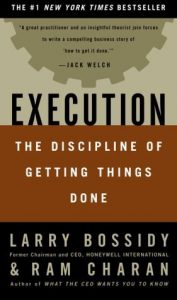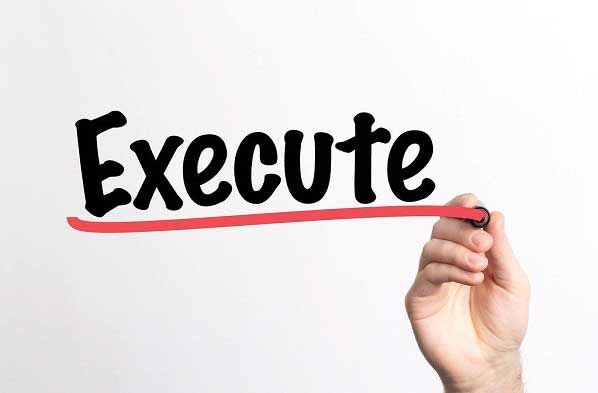
Recommended Reading:
Bossidy, L. & Charan, R. (2002). Execution: the Discipline of Getting Things Done. New York: Crown Business Books.
“Execution is the great unaddressed issue in the business world today. Its absence is the single biggest obstacle to success and the cause of most of the disappointments that are mistakenly attributed to other causes.”
― Ram Charan, author of What the CEO Wants You to Know and Boards that Work.
In the year 2000 alone, forty CEOs of the top 200 companies on Fortune’s 500 list were removed— fired or made to resign. When 20 percent of the most powerful business leaders lose their jobs, something is clearly wrong.
Leaders make big promises… and then there are big gaps in what their organizations actually deliver. They have problems with accountability—people aren’t doing what they’re supposed to do.
Execution is not just something that does or doesn’t get done. Execution is a culture with specific set of behaviors and techniques that companies need to master in order to have competitive advantage.
Execution is not only the biggest issue facing business today, it is something nobody has explained satisfactorily. Execution is not just tactic—it is a discipline and a system. It has to be built into a company’s strategy, its goals, and its culture. And the leader of the organization must be deeply engaged in it.
“Many people regard execution as detail work that’s beneath the dignity of a business leader. That’s wrong … it’s a leader’s most important job.” ― Larry Bossidy, former chairman and CEO, Honeywell International
According to Ram Charan and Larry Bossidy in their book Execution (2002), a lack of focus on the discipline of execution is the main reason companies fall short on their promises. It explains the gap between what leaders want and what they deliver. Execution is a system of getting things done through questioning, analysis and follow-through. It is a discipline for meshing strategy with reality, aligning people with goals, and achieving the results promised. It should be a central part of a company’s strategy and goals, and the most important job of any leader.
It requires a comprehensive understanding of the business, its people, and its environment. An execution culture links the three core processes of any business—the people process, the strategy, and the operating plan—together to get things done on time.
The execution phase forces the leaders to translate the broad-brush conceptual understanding of the company’s strategy into an action plan for how it will all happen: who will do what in which sequence, how long those tasks will take, how much will they cost, and how they will affect subsequent activities.
Execution is a systematic process of rigorously discussing “what, how, and why,” of questioning, tenaciously following through, and of ensuring accountability. In its most fundamental sense, execution is a systematic way of exposing reality and acting on it. Most companies do not face reality very well. That is the basic reason they can’t execute.

Which people will do the job—and how will they be judged and held accountable?
People engaged in the processes argue these questions, search out reality and reach specific and practical conclusions. Everybody agrees about their responsibilities for getting things done, and everybody commits to those responsibilities.
The heart of execution lies in the three core processes: the people process, the strategy process and the operations process. Every business uses these processes in one form or another.
The three core processes of people, strategy and operations are familiar to practitioners of the Balanced Scorecard and the Strategy-Focused Organization management approaches.
In a study of winning companies over ten years, professors William Joyce and Nitin Nohria found there were four primary management practices that directly correlate with superior corporate performance, as measured by total return to shareholders. Winning companies achieve excellence in all four of these primary practices: execution, strategy, culture and structure (What Really Works, 2003).
However, more often than not, these core processes stand apart from one another like silos. Typically, the CEO and his senior leadership team allot less than half a day each year to review the plans—people, strategy, and operations. Typically, too, the reviews are not particularly interactive. People sit passively and watch PowerPoint presentations.
They don’t debate, and as a result often they get few useful outcomes. People leave with no commitments to the action plans they’ve helped create. This is a formula for failure. What is needed is:
You cannot have an execution culture without robust dialogue—one that brings reality to the surface through openness, candor and informality. Robust dialogue requires that an organization has the information it needs to understand reality, and has the ability to make the right decisions.
When mistakes are made, openness is preserved and blaming avoided. The information is used for course correction. Candor and honest conversations foster creativity and ultimately lead to competitive advantage and shareholder value.
I t takes emotional fortitude to be open to whatever information you need, whether it is what you want to hear or not. Such fortitude gives you the courage to accept opposite points of view and deal with conflict. It takes a special kind of confidence to encourage and accept challenges in group settings. It is necessary to be able to accept and deal with your own weaknesses or vulnerabilities, to be firm with people who aren’t performing, and to handle the ambiguity inherent in fast-moving, complex organizations.
Bossidy and Charan point out four core qualities that make up emotional fortitude and that are required for all leaders:
Clearly these four qualities should be well-developed by the time an executive reaches a top position within a corporation. However, often one or two of them may appear to be underdeveloped. Leadership development at this level requires the services of a professionally trained executive coach to provide focus and guidance in enhancing these four qualities.
Leaders often bristle when they are told they have to run the three core processes themselves. “You’re telling me to micromanage my people, and I don’t do that,” is a typical response. Micromanaging is a big mistake because it diminishes people’s selfconfidence, saps their initiative and stifles their ability to think for themselves.
But there’s an enormous difference between leading an organization and presiding over it. The leader who boasts of a hands-off style or puts faith in empowerment is not dealing with the issues of the day. He or she is not confronting the people responsible for poor performance, or searching for problems to solve and then making sure they get solved.
Leaders—at all levels—must become passionately engaged in the organization, recognizing that execution is their main job. Putting the right people in the right jobs and ensuring that rewards and recognition reinforce performance are essential.
Bossidy and Charan emphasize that leaders must build and sustain a “social operating system,” involving continuous review meetings that make up the day-to-day execution management and to link performance and rewards. Review meetings provide the framework needed to create common ways of thinking, behaving and doing.
What exactly does a leader in charge of execution do? How does she or he keep from being a micromanager, caught up in the details of running the business? There are seven essential behaviors that form the building blocks of execution:
Most executives and managers don’t understand the “discipline” of execution. It is not simply a matter of trying harder or paying more attention to details. Execution involves a specific set of core processes built on a foundation of leadership behaviors; it’s a culture unto itself.

Bossidy, L. & Charan, R. (2002). Execution: the Discipline of Getting Things Done. New York: Crown Business Books.